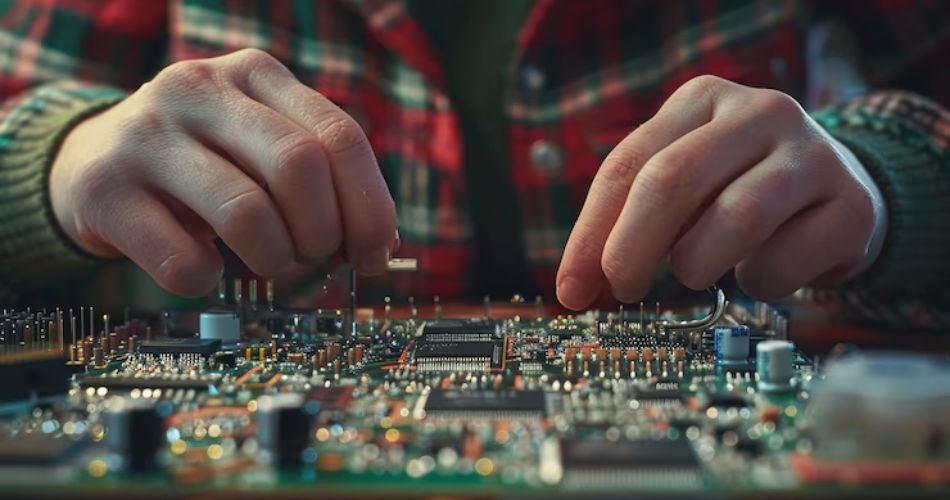The term nvs0603b150a may not sound familiar to the average consumer, but in the world of electronics, this tiny surface-mount component plays a significant role. It’s commonly recognized as a ferrite bead or inductor that helps suppress high-frequency noise in circuits. As electronics get smaller and more complex, components like this become essential for maintaining signal integrity and power efficiency. Whether you’re designing a smartphone, automotive ECU, or IoT device, integrating an nvs0603b150a into your design can drastically improve performance by eliminating electromagnetic interference (EMI) that often disrupts electronic signals.
What Exactly Is nvs0603b150a?
At its core, the nvs0603b150a is a passive electronic component, generally categorized as a ferrite bead. It serves the critical function of filtering unwanted high-frequency noise from circuits without affecting the direct current (DC) or low-frequency alternating current (AC) signals. This makes it ideal for power supply lines or signal lines where digital components could be disrupted by stray RF noise. Its size—0603 in imperial measurement (1.6mm x 0.8mm metric)—is perfect for high-density circuit boards. These beads work silently in the background, ensuring devices operate without interruption or interference.
Manufacturing Standards and Origin of nvs0603b150a
The nvs0603b150a is typically manufactured by top-tier electronics component companies such as Murata, TDK, Taiyo Yuden, and Samsung Electro-Mechanics. These companies are known for producing high-reliability components used in aerospace, medical, consumer electronics, and industrial systems. The part number nvs0603b150a follows a systematic naming convention that helps identify its physical dimensions, material composition, and electrical characteristics. These manufacturers comply with global safety and environmental standards, including RoHS and REACH regulations, which ensure the component is safe for use in various regulatory markets.
Technical Specifications of nvs0603b150a
When choosing an electronic component, understanding its specifications is crucial. The nvs0603b150a typically offers an impedance of 15 ohms at 100 MHz, with a rated current capacity ranging between 200 mA to 500 mA depending on the variant. Its DC resistance (DCR) is usually low—around 0.05 ohms—which minimizes voltage drops across the component. It operates efficiently in a temperature range from -40°C to +125°C, making it highly adaptable to extreme conditions, including automotive and industrial environments. These specs contribute to its ability to suppress high-frequency noise while maintaining circuit integrity.
Physical Characteristics and Design Compatibility
One reason the nvs0603b150a is so popular is its small and manageable size. Measuring just 1.6mm x 0.8mm, it conforms to the 0603 (imperial) package standard for surface-mount technology (SMT). This compact footprint allows it to be placed directly on printed circuit boards (PCBs) without taking up unnecessary space—an important factor in modern miniaturized designs. Despite its small size, this ferrite bead is clearly marked and manufactured to endure stress from soldering and thermal cycling. This makes it ideal for densely packed electronics where space-saving is a priority but performance cannot be compromised.
Applications of nvs0603b150a in Consumer Electronics
The use of nvs0603b150a spans across a wide array of devices we interact with daily. In smartphones, for example, it is placed in power lines and signal paths to prevent RF interference that could affect audio clarity, camera module operation, or touch screen sensitivity. Tablets, laptops, and gaming devices also incorporate this component in areas where digital signals are prone to picking up noise—such as USB interfaces, display panels, and processor power inputs. The result is improved device performance, better energy efficiency, and enhanced user experience without noticeable latency or disruptions.
Automotive Integration and Benefits
As modern vehicles continue to incorporate more electronic systems, the need for noise suppression increases. In automotive electronics, nvs0603b150a is used in modules such as engine control units (ECUs), infotainment systems, dashboard displays, and advanced driver-assistance systems (ADAS). These systems rely on clean power and uninterrupted communication between sensors and processors. Even a small interference spike could lead to malfunction or delay, so the ferrite bead acts as a gatekeeper by absorbing high-frequency noise. Moreover, its high operating temperature range allows it to survive the thermal fluctuations typical in engine compartments and interiors.
Telecommunications and Networking Applications
Routers, modems, and cellular base stations rely heavily on components like nvs0603b150a to keep signal paths clean and efficient. When multiple high-frequency signals interact within one device, the potential for cross-talk and interference increases. This bead ensures that power lines feeding RF modules, processors, and signal amplifiers do not introduce noise into the transmission or reception chains. The result is clearer signals, better data integrity, and improved overall performance. This component is often found near USB ports, Ethernet transformers, and antenna modules in communication devices.
Choosing the Right nvs0603b150a for Your Project
Not all ferrite beads are created equal, and while nvs0603b150a is a specific part number, variations exist depending on the manufacturer. Always examine the datasheet for key specs like impedance rating, current capacity, and DCR. When substituting, ensure the equivalent part has matching or better specifications. Choosing a bead with too low impedance won’t block enough noise, while too high an impedance might affect your signal integrity. For developers working on high-speed or RF circuits, simulation software like SPICE can be useful to model the effect of the bead in the circuit before physical implementation.
Soldering and Handling Tips
Due to its size, the nvs0603b150a requires careful handling during soldering. Surface-mount components are best installed using reflow soldering techniques, where solder paste is applied and the board is passed through a controlled oven. Manual soldering can work for prototyping but requires precision to avoid thermal or mechanical damage. Use tweezers and ESD-safe tools to place the component on the board, and ensure proper orientation as indicated in the PCB layout. Avoid excessive heat or prolonged contact with the soldering iron, which can degrade the internal structure of the bead.
Common Issues and Troubleshooting
While nvs0603b150a is reliable, failures can occur due to overcurrent, mechanical stress, or manufacturing defects. Symptoms of failure include an increase in EMI, random system resets, or heat generation in the circuit. Testing the component with a multimeter or impedance analyzer can help identify issues. If the bead shows significant deviation from expected resistance or impedance, replacement is necessary. In high-volume production, automated optical inspection (AOI) and in-circuit testing (ICT) help detect soldering and orientation errors that may affect the component’s performance.
Sourcing and Availability in the Global Market
Sourcing reliable nvs0603b150a components is easy through global distributors such as Digi-Key, Mouser, RS Components, and Arrow. Most vendors offer bulk discounts and stock up on different variants to suit a range of applications. When purchasing, ensure the supplier is authorized to avoid counterfeit components, which may not meet reliability standards. Check for certifications like ISO9001 or traceability documentation if you’re sourcing for critical applications in healthcare or aerospace. Always compare datasheets from different manufacturers to verify performance and compatibility.
Cross-Reference and Substitution Options
In cases where nvs0603b150a is unavailable, equivalent ferrite beads from other brands may be considered. Look for parts from the Murata BLM series, TDK MPZ series, or AVX’s FBC series with similar impedance and current ratings. Most datasheets include a cross-reference table for alternatives. However, physical dimensions and pad layouts must also match if the PCB has already been fabricated. Always revalidate performance through bench testing or simulation before mass production when substituting components in critical designs.
Environmental and Compliance Benefits
Electronic components today must meet strict environmental standards, and nvs0603b150a is no exception. Most models are RoHS-compliant, meaning they do not contain hazardous substances like lead, mercury, or cadmium. They also comply with the EU’s REACH regulation for chemical safety. For products being exported globally, especially into Europe or Japan, these compliance measures are non-negotiable. Additionally, as part of responsible manufacturing, companies often provide lifecycle data to guide proper recycling and disposal methods for end-of-life management.
Conclusion
In the vast ecosystem of electronic components, the nvs0603b150a stands out not for its flashiness but for its necessity. This tiny, nearly invisible component ensures that power lines remain quiet, signals stay clean, and devices operate flawlessly. From consumer gadgets to mission-critical systems, its role is universal and indispensable. Whether you’re an engineer designing a next-gen wearable or a technician repairing network gear, understanding and using the right ferrite bead like the nvs0603b150a can be the silent key to your success.






